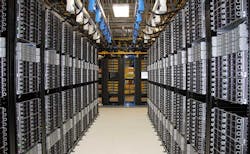New technologies in the data center, such as rise of artificial intelligence and the GPU computing hardware that often supports it, are boosting the development of new strategies and designs for high-density cooling for data centers. At Data Center Frontier we’ve been tracking this trend closely, and bring you this guide to our coverage of high-density cooling.
The Big Picture: Trends in high-density cooling
As Power Densities Rise, Providers Lead With Cooling : New hardware for cloud computing and machine learning is bringing beefier workloads into the data center, creating opportunity for service providers specializing in high-density cooling.
AI Boom Boosts GPU Adoption, High Density Cooling : The rise of artificial intelligence, and the GPU computing hardware that often supports it, is reshaping the data center industry’s relationship with power density.
Companies, Technologies and Solutions:
New companies and technologies are popping up in the data center cooling market. Here’s a look at some of the companies and data center designs we’ve profiled at DCF:
Liquid Cool Brings Immersion Cooling to the Server Chassis : LiquidCool Solutions immerses server components inside a sealed chassis filled with dielectric fluid. The company is targeting the market for high-density cooling, where the growth of AI and HPC is boosting interest in liquid-cooled solutions.
Ebullient Cooling uses a “boiling jet” module that sits on top of the processors to remove heat. (Photo: Rich Miller)
Ebullient Aims to Take Liquid Cooling Beyond the HPC Market : Ebullient Cooling has introduced a two-phase liquid cooling solution that delivers dielectric fluid directly to the processor. The data center cooling startup says it is gaining wins in the HPC sector, but also sees opportunities in the small business market.
Aquarius Server: Warm Water Cooling for Open Compute : Aquila Systems and cooling specialist Clustered Systems introduced a new server offering warm-water liquid cooling for hyperscale data centers using Open Compute designs.
Colovore Pre-Leases New Phase of Water-Cooled Data Center: In a sign of strengthening demand for water-cooled racks, high-density hosting specialist Colovore has fully pre-leased a 2 megawatt expansion of its Santa Clara data center.
Inside Linked-In’s Portland Data Center : The new LinkedIn data center in Hillsboro, Oregon breaks new ground in Internet-scale data centers, combining high density with exceptional efficiency and sustainability. Here’s a closer look at the project and its design.
Want to learn more about high-density cooling for data centers? Take a look at the following white paper resources, which cover the ins and outs of data center liquid cooling, airflow management and free cooling:
Data Center Liquid Cooling : This special report explores how next generation data centers will overcome the inherent disadvantages around air cooling through liquid cooling technologies. Readers learn how, representing a paradigm shift in cooling technology, these new types of liquid cooling platforms are revolutionizing hardware design, development, and digital data center deployment.
Keep pace with the fact-moving world of data centers and cloud computing by following us on Twitter and Facebook, connecting with Data Center Frontier editor Rich Miller on LinkedIn, and signing up for our email news update using the form below.


